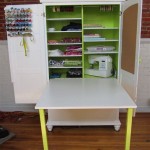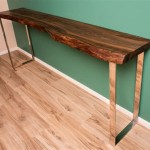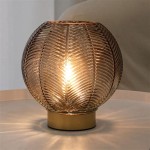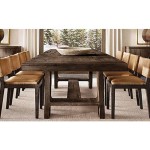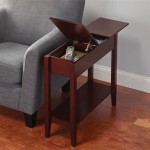Understanding 3-Way Table Lamp Switches
A 3-way table lamp switch is a specialized electrical component that allows a lamp to operate at three distinct levels of illumination: low, medium, and high, in addition to an off state. This functionality is achieved through a combination of the switch's internal circuitry, a specialized 3-way bulb, and the wiring connecting these components. The purpose of this article is to provide a comprehensive understanding of how 3-way table lamp switches function, their internal mechanisms, wiring configurations, troubleshooting techniques, and maintenance procedures. Such knowledge is beneficial for anyone involved in electrical repairs, DIY projects, or simply those wishing to understand the operation of household appliances.
Unlike a standard on/off switch, a 3-way switch does not simply break or complete a single circuit. Instead, it manages two separate circuits within the lamp. This allows the lamp to utilize different filaments within the 3-way bulb, each possessing a different wattage. By selecting the appropriate setting on the switch, one can choose to power either the lower wattage filament, the higher wattage filament, or both filaments simultaneously, resulting in the three levels of brightness.
The 3-way functionality provides increased versatility in lighting. It allows for adjusting the light output to suit different tasks or ambiances. A low setting may be suitable for a night light, while a higher setting may be preferable for reading or other activities requiring more intense illumination. This adaptability makes 3-way lamps and their corresponding switches a common feature in residential settings.
Fundamental Principles of 3-Way Switching
The core concept behind 3-way switching lies in the manipulation of multiple circuits using a single controlling device. In the case of a 3-way table lamp, the switch selectively directs electrical current through one of two filaments within the bulb, or through both concurrently. To understand this, it's necessary to consider the internal structure of both the switch and the bulb.
A typical 3-way bulb contains two independent filaments. One filament is designed for lower wattage, providing a dimmer light output, while the other filament is of higher wattage, producing a brighter light. The bulb base incorporates a third contact point, in addition to the standard neutral contact, to accommodate the separate connections required for the two filaments. This third contact is crucial for differentiating a 3-way bulb from a standard bulb.
The 3-way switch contains multiple internal contacts that allow for the selection of different circuit paths. When the switch is in the "low" position, it completes a circuit that powers only the lower wattage filament. In the "medium" position (often obtained by switching twice from the "off" position), it energizes the higher wattage filament. Finally, in the "high" position (achieved by switching again), it activates both filaments simultaneously, resulting in the maximum light output. The fourth position returns the switch to the "off" state, disconnecting both filaments from the power source.
This cyclical operation – low, medium, high, off – is achieved through a mechanical indexing mechanism within the switch. Each rotation of the switch knob or button advances the internal contacts to the next position in the sequence, effectively altering the current path and, consequently, the brightness of the lamp.
It is important to note that a standard single-filament bulb will not function correctly in a 3-way lamp. Using a standard bulb may result in no light output at all, or it may cause damage to the bulb or the lamp's wiring. The 3-way lamp is specifically designed to work with the unique characteristics of a 3-way bulb.
Internal Components and Operation of the Switch
The 3-way table lamp switch is a relatively simple device comprised of a few key components that work in concert to achieve its functionality. These components include the switch housing, the rotating or sliding mechanism, the internal contacts, and the wiring terminals. The switch housing provides a protective enclosure for the internal components and typically includes a knob or button for user operation. The rotating or sliding mechanism is directly connected to the knob or button and is responsible for physically moving the internal contacts between different positions.
The internal contacts are the heart of the switch's operation. These are typically made of a conductive material, such as brass or copper, and are arranged in a specific configuration to allow for the selective connection of the different circuits. The contacts are designed to make and break electrical connections as the switch is rotated or slid into different positions. The arrangement and number of contacts are critical for achieving the distinct low, medium, high, and off settings.
The wiring terminals are the points where the electrical wires from the lamp cord and the bulb socket are connected to the switch. These terminals are typically screw terminals or push-in connectors that provide a secure and reliable electrical connection. The correct wiring configuration is essential for the proper operation of the 3-way lamp. Incorrect wiring can lead to malfunctions, such as the lamp only working on one setting, or potentially create a safety hazard.
The operation of the switch can be visualized as a rotating or sliding cam mechanism that moves the internal contacts into different positions. Each position corresponds to a specific combination of filament connections in the bulb. For example, in the “low” position, the cam mechanism connects the power source to the terminal leading to the low-wattage filament. In the “high” position, it connects the power source to both the low and high-wattage filament terminals simultaneously. This precise mechanical action allows for the controlled switching between different light levels.
Over time, the internal contacts of the switch can become corroded or worn, leading to intermittent or unreliable operation. Dust and debris can also accumulate inside the switch housing, interfering with the smooth movement of the mechanical components. Regular cleaning and maintenance can help to prolong the life of the switch and ensure its continued functionality.
Troubleshooting and Maintenance
Diagnosing problems with a 3-way table lamp often involves systematically checking each component to isolate the source of the issue. Common problems include the lamp not turning on at all, only working on one or two settings, flickering, or exhibiting erratic behavior. The first step in troubleshooting is to ensure that the bulb is functioning correctly. Replace the bulb with a known good 3-way bulb to rule out a faulty bulb as the cause of the problem.
If the bulb is not the issue, the next step is to inspect the wiring connections within the lamp. Check the connections at the bulb socket, the switch terminals, and the plug. Ensure that all connections are secure and free from corrosion. Loose or corroded connections can cause intermittent contact and lead to the lamp malfunctioning. It's crucial to disconnect the lamp from the power source before inspecting any wiring to prevent electrical shock.
If the wiring connections appear to be in good condition, the problem may lie within the 3-way switch itself. The switch can be tested using a multimeter to check for continuity between the various terminals in each switch position. If the multimeter shows no continuity in any of the positions, or if the continuity is intermittent, the switch is likely faulty and needs to be replaced. Before testing, ensure the lamp is unplugged from the power source.
Replacing a 3-way switch is a relatively straightforward process, but it requires careful attention to detail. Before removing the old switch, take note of the wiring configuration, either by drawing a diagram or taking a photograph. This will ensure that the new switch is wired correctly. When installing the new switch, ensure that the wires are securely connected to the terminals and that the switch is properly seated in the lamp housing.
Preventative maintenance can help to extend the life of the 3-way switch and the lamp. Periodically cleaning the lamp and switch with a dry cloth can remove dust and debris. Avoid using excessive force when operating the switch, as this can damage the internal components. If the switch becomes difficult to rotate or slide, a small amount of electrical contact cleaner can be applied to the internal contacts to improve their conductivity. However, use contact cleaner sparingly and follow the manufacturer's instructions carefully.
If the lamp cord shows any signs of damage, such as fraying or cracking, it should be replaced immediately. A damaged lamp cord can pose a serious electrical hazard. When replacing the lamp cord, use a cord of the same gauge and type as the original. Carefully strip the insulation from the wires and connect them to the appropriate terminals in the lamp base and plug. Ensure that all connections are secure and properly insulated.
By following these troubleshooting and maintenance tips, one can effectively diagnose and repair common problems with 3-way table lamps and extend the life of these valuable lighting fixtures.

28 White And Cream Traditional 3 Way Switch Table Lamp Walmart Com

Signature Home Collection 29 5 Natural White And Black 3 Way Switch Table Lamp Walmart Com

Monarch Specialties Table Lamp With 3 Way Switch Transitional Design At Tractor Supply Co

30 Retro Glass Table Lamp With 3 Way Switch Purple Ore International

3 Way Dimmable Touch Control Table Lamp Set Of 2 With Dual Usb Charging Ports Ebay

3 Way Desk Light Parts Touch Control Sensor Lamp Switch Dimmer For Bulbs Ebay

Allen Roth Table Lamp With Faux Marble 3 Way Switch 25 In Metal Fabric Brushed Nickel White Gs T016262bn Rona

Yansun 17 In Chrome Led Integrated Table Lamp With 3 Way Dimmer Rotary Switch And Dual Usb Charging Ports H Dl013 The Home

Set Of 2 Farmhouse Table Lamps With Rotary Switch 3 Way Dimmable Bedside Touch Lamp Usb Ports Bedroom Nightstand Rustic Desk For Living Room Reading Bulbs Included Walmart Com

27 Inch Black Metal Table Lamp With Gooseneck Task Reading 3 Way Switch 2 Piece Set Living Spaces




